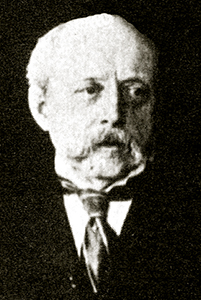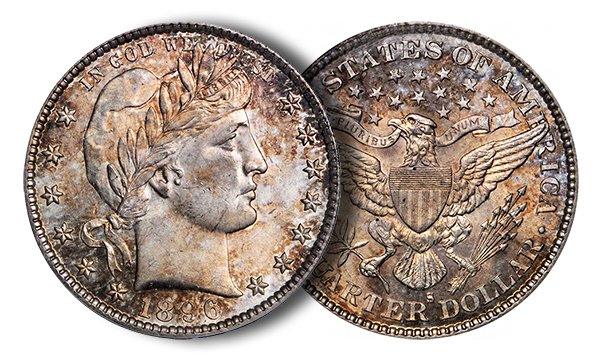Coin Rarities & Related Topics: News and Analysis regarding scarce coins, coin markets, and the coin collecting community #235
A Weekly CoinWeek Column by Greg Reynolds….
 Barber Quarters are a popular series of U.S. coins. When I was a kid, I was extremely interested in them. Even now, heavily circulated, non-rare Barber Quarters are available to non-wealthy collectors, as a large number sell for less than twelve dollars each. The keys, though, are dramatically more expensive. The second scarcest of the three ‘key date’ Barber Quarters is the 1896-S. A gem quality 1896-S will be offered in the upcoming Rarities Night Session by Stack’s-Bowers (SBG) on Aug. 6th, at the ANA Convention in Rosemont, Illinois. Last week, there was coverage of a key 1849-O Liberty Seated Quarter in this same auction session.
Barber Quarters are a popular series of U.S. coins. When I was a kid, I was extremely interested in them. Even now, heavily circulated, non-rare Barber Quarters are available to non-wealthy collectors, as a large number sell for less than twelve dollars each. The keys, though, are dramatically more expensive. The second scarcest of the three ‘key date’ Barber Quarters is the 1896-S. A gem quality 1896-S will be offered in the upcoming Rarities Night Session by Stack’s-Bowers (SBG) on Aug. 6th, at the ANA Convention in Rosemont, Illinois. Last week, there was coverage of a key 1849-O Liberty Seated Quarter in this same auction session.
This 1896-S is PCGS graded MS-65 and has a sticker of approval from the CAC. Heavily circulated 1896-S quarters are not nearly as valuable as this one. In May 2013, SBG auctioned a PCGS graded Fair-02 1896-S for $258.50, and, in March 2014, SBG auctioned a different PCGS graded Fair-02 1896-S for this same price. It would be hard to purchase an 1896-S quarter with a PCGS or NGC numerical grade for a lower amount.
In Feb. 2012, SBG auctioned an NGC graded AG-03 1896-S for $356.60. More recently, in March 2014, SBG auctioned a PCGS graded Good-04 1896-S for $628.63. In Aug. 2012, a PCGS graded EF-45 coin, from a collector consignment, was auctioned for $4636.80.
Of course, gem quality 1896-S quarters are worth more. By tradition, coins that grade 65 or higher are termed ‘gems.’ PCGS graded MS-65 1896-S quarters tend to retail for amounts in the range of $45,000 to $65,000.
PCGS has graded ten 1896-S quarters and NGC has graded seven as “MS-65.” Each service has graded two as “MS-66” and NGC has graded one 1896-S as “MS-67,” which is in the collection of Eugene Gardner. These twenty-two certified ‘gems’ amount to maybe fifteen different coins. Importantly, most have become unnaturally white, from having been artificially brightened via dipping or other means in the near past. Some have problems as well.
It is noteworthy that the CAC has approved just three PCGS or NGC graded MS-65 1896-S quarters and zero at a higher level. Also, the CAC has approved zero 1896-S quarters at the MS-64 level. Reportedly, PCGS has graded twelve as MS-64 and NGC has graded fourteen, though I am certain that these are not twenty-six different coins. The condition rarity of 1896-S quarters has not been fully recognized by those interested.
A theme here is that, more so than survivors of other key or better date Barber Quarters, certified MS-65 or higher grade 1896-S quarters tend to have awkward, oddly white surfaces. The ‘gem’ 1896-S in this SBG auction distinguishes itself from the pack by having considerable natural toning.
I. What are Barber Quarters?
 Charles Barber designed Barber Dimes, Barber Quarters and Barber Half Dollars, which all have very similar obverse (front) designs. The reverse designs of Barber Quarters and Barber Halves are very similar, while the reverse design of the dime is quite different. Barber Quarters, like Barber Dimes, were minted from 1892 to 1916. Barber Halves were not minted after 1915.
Charles Barber designed Barber Dimes, Barber Quarters and Barber Half Dollars, which all have very similar obverse (front) designs. The reverse designs of Barber Quarters and Barber Halves are very similar, while the reverse design of the dime is quite different. Barber Quarters, like Barber Dimes, were minted from 1892 to 1916. Barber Halves were not minted after 1915.
Charles Barber also designed Liberty or ‘Vee’ Nickels, which date from 1883 to 1913. These are never called Barber Nickels and their design is much different from that of Barber Quarters. In addition, Charles Barber designed medals and commemoratives. Further, he modified designs of others, such as those put forth by Augustus Saint Gaudens for gold coins. His father, William Barber, was also an employee of the U.S. Mint and was responsible for the designs of several interesting patterns.
In many cases, a collector will assemble sets of Barber Dimes, Barber Quarters and Barber Halves. Some collectors just focus on one of these three types. It is common for collectors to focus on one denomination, such as quarters. Someone who collects Standing Liberty Quarters (1916-30) or Liberty Seated Quarters (1838-91) is likely to collect Barber Quarters as well.
There are three keys to a set of Barber Quarters. All three were struck at the San Francisco Mint: the 1896-S, the 1901-S and the 1913-S. It matters to some collectors that the 1896-S was produced in the 19th century. The 1901-S is, by far, the scarcest and most expensive of the three. Finding a very much naturally toned, gem 1896-S, however, is more difficult than finding a very much naturally toned, gem 1901-S.
II. This 1896-S ‘In The News’!
The 1896-S quarter in this SBG auction has really neat orange-russet toning with underlying vibrant luster. It is more than very attractive, with the reverse (tail) being more attractive than the obverse (head). Plus, the reverse is of higher quality overall than the obverse.
I theorize that, throughout most of the history of U.S. coin collecting, the grade of the obverse has counted for about two-thirds of a coin’s overall grade and the grade of the reverse for one-third. Richard Burdick tends to “agree.” Others, though, have voiced contrary opinions, such as “55% to 45%” or “70% obverse, 30% reverse.” One of the sharpest graders in the coin business argues, however, that “the reverse can only bring the grade down; it cannot bring it up”!
If the obverse of a coin grades 63 and the reverse grades 67, would it make sense to grade the whole coin as 63? Such a coin would probably grade 64 or 64+! In contrast, if the obverse of a coin grades in the middle of the 67 range and the reverse grades in the high end of the 63 range, the overall grade of the coin would make it into the 66 range, in my view.
 It is debatable as to whether the obverse of the present 1896-S grades MS-65. There are noticeable contact marks right in the middle of Miss Liberty’s face and more in the nearby field. The reverse, however, is wonderful. The orange-russet and blue toning on the reverse in addition to the nearly flawless surfaces contribute to the grade of the reverse almost reaching the MS-67 level.
It is debatable as to whether the obverse of the present 1896-S grades MS-65. There are noticeable contact marks right in the middle of Miss Liberty’s face and more in the nearby field. The reverse, however, is wonderful. The orange-russet and blue toning on the reverse in addition to the nearly flawless surfaces contribute to the grade of the reverse almost reaching the MS-67 level.
So, if the obverse grades in the high end of the 64 range, nearly MS-65, and the reverse grades in the high end of the 66 range, nearly MS-67, then the grade of the whole coin is in the middle of the MS-65 range! Although I am not suggesting that I or anyone else can precisely and consistently grade coins to the tenth of a point, the use of tenths may be educational in a discussion of this coin. Suppose that the obverse grades 64.8 and the reverse grades 66.7, which are fair numbers for this respective coin. If the obverse counts for two-thirds, the overall grade would then be 65.43, {((2*64.8)+66.7)/3 = 65.43}. It may be true, however, that some experts assign a grade in the 65 range to the obverse by itself. It is lively and notably appealing.
There will always be legitimate differences of opinion among experts regarding the grades of individual coins. According to currently accepted grading criteria, 65 grade coins may have some very noticeable contact marks on the face of Miss Liberty, yet such marks were not allowed in the 1980s and early 1990s. Even considering the contact marks on her face, I prefer this coin to the other certified “MS-65” 1896-S quarter that I now remember. This 1896-S is very attractive and certainly scores higher in the category of originality than several of the others.
Heritage auctioned John Hugon’s collection of Barber coins on Jan. 12, 2005 in Fort Lauderdale. Although the PCGS graded MS-65 Hugon Collection 1896-S would be considered a gem by most relevant wholesalers and other graders,it has too much of a ‘dipped look’ for most (though not all) sophisticated collectors of gem quality, classic U.S. coins.
The views of sophisticated collectors regarding natural toning and originality are discussed in a three part series in 2009. A more recent discussion focuses on the topic of dipping and building excellent collections.
In Jan. 2012, Heritage auctioned a different PCGS graded and CAC approved MS-65 1896-S quarter, for $47,437.50. This coin was very obviously dipped, not long before 2012, and a haze formed since that dipping. It, too, had some noticeable imperfections on the obverse, though perhaps to a lesser extent than on the presently discussed coin. The dipping and the haze are bothersome. I am not challenging the grade of that coin, nonetheless, as most leading dealers accept such artificially white Barbers as gem quality coins. Besides, it had begun to noticeably, naturally retone before Jan. 2012 and it could become a more appealing coin in the future.
The PCGS graded MS-65 1896-S that SBG auctioned in Nov. 2013 has very obviously been dipped in the not distant past. Indeed, it has probably been dipped on multiple occasions. Moreover, it has some significant abrasions on the face and neck. Some ‘stuff’ is covering or at least obscuring a few of these abrasions. I wonder how this coin would appear if it was immersed in acetone, which removes most ‘stuff’ resting on a coin’s surface without noticeably affecting natural toning. That coin brought $47,000 in 2013 and the presently discussed PCGS graded MS-65 1896-S is much more desirable.
While I have probably never seen the NGC graded MS-66 1896-S that Heritage auctioned in Nov. 2012, it is obvious from the images published online that it does not have much (if any) noticeable toning and has been artificially brightened. It may have been otherwise ‘conserved’ as well. It went for $49,937.50. If most relevant experts had graded it as MS-66, it would have sold for a price in the range of $58,500 to $75,000, or even more. A true MS-66 grade 1896-S quarter would be a tremendous prize!
Another NGC graded “MS-66” 1896-S was auctioned in the Jan. 6, 2011 Platinum Night event in Tampa. Although I attended this event and viewed lots before the sale, for some reason, I did not see this particular coin. From the published images, however, it is apparent that it had not been dipped within a few years before 2011. Also, I have not received any feedback about this particular coin from other experts. There are two reasons to mention it here. First, it is clear that the two “MS-66” grade 1896-S quarters that NGC lists are really two different coins. Second, this coin does not have the blatantly-dipped ‘look’ of many certified, gem 1896-S quarters. It sold at auction for more than the just mentioned ‘white’ NGC graded MS-66 1896-S, $57,588.55 versus $49,937.50, though again I suggest that a ‘solid’ MS-66 1896-S would be worth considerably more than $57,500.
A conclusion is that naturally toned and not doctored 1896-S quarters that truly grade above MS-64 are tremendous condition rarities. These are more elusive than corresponding 1901-S and 1913-S quarters.
The 1896-S that SBG will auction in the Rarities Night session of Aug. 6 is the best 1896-S that I remember ever seeing. I attended the pertinent Eliasberg, Pittman, Duckor, and Hugon sales. I have been carefully examining, gem quality Barber Quarters for more than twenty years!
©2014 Greg Reynolds





The big thing about grades is that to get the top, the coin should be original. Blast counts more than marks. If a coin comes to greet you, then it has blast. If it is mark free but has no blast, it will get a much lower grade.